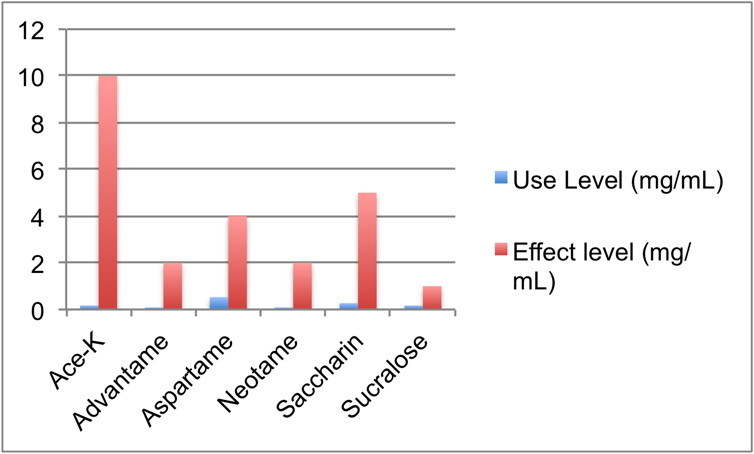Bioluminescent Bacteria Don't Like Sweeteners
by D. Eric Walters, Ph.D.
Another new study! This one, titled "Measuring artificial sweeteners toxicity using a bioluminescent bacterial panel," was published in the journal Molecules (volume 23, 2454, 2018). It led to web headlines like these:
- ARTIFICIAL SWEETENERS, SPORT SUPPLEMENTS COULD BE TOXIC TO YOUR GUT, STUDY SAYS
- ARTIFICIAL SWEETENERS TURN YOUR OWN BODY AGAINST YOU
- MORE BAD NEWS FOR ARTIFICIAL SWEETENER USERS
- ARTIFICIAL SWEETENERS HAVE TOXIC EFFECTS ON GUT MICROBES
Should you be worried?
The authors of this paper used three strains of E. coli that were genetically engineered to produce bioluminescence, and the bioluminescence was linked to heat shock genes in one strain, fatty acid metabolism genes in the second strain, and DNA damage genes in the third strain. These bacteria were grown in 96 well plates, using 90 microliters of bacterial culture. To the plate was added 10 microliters of a sweetener solution, or 10 microliters of a reconstituted sport supplement, or 10 microliters of culture medium as a control. Sweetner concentrations ranged from 0.000001 to 10 milligrams per milliliter (mg/mL). If the bioluminescence changed, the investigators conclude that gene expression changed in the bacteria. Significantly, all three strains appear to have done better in the control experiment, even when compared to vanishingly small quantities of sweetener, probably because they got 11% more nutrient media.
Six sweeteners (aspartame, sucralose, saccharin, advantame, neotame, and acesulfame-potassium) and 10 sport supplements were tested. I will not attempt to interpret the results from the 10 sport supplements tested. Each of these products contained dozens of ingredients, and it would be impossible to dissect the sweetener effect from the rest of the mixture. The following analysis applies to bioluminescence effects of the sweeteners.
Results:
- Acesulfame-K affected only one strain, at a concentraion of 10 mg/mL
- Advantame had no effect on the bioluminescence of any strain
- Aspartame affected only one strain, at a concentration of 4 mg/mL
- Neotame affected two strains, at a concentration of 2 mg/mL
- Saccharin affected two strains, at a concentration of 5 mg/mL
- Sucralose affected all three strains, at concentrations of 1, 50, and 100 mg/mL, respectively
Toxicologists know that everything is toxic, depending on the dose. Salt, water, sugar, and even a mother's love produce deleterious effects when given in inappropriate amounts (that's a direct quote from Professor Lewis D. Stegink, of the University of Iowa). So the big question is whether these concentrations are relevant to the bacteria that live in your gut. Use levels for these six sweeteners range from 0.002 to 0.5 mg/mL in soft drinks. The graph below shows a comparison of use level in soft drinks (blue bars), compared to the minimum concentrations that caused an effect on the bacteria tested (red bars). Advantame showed no effect on bacterial luminescence, but was tested at 2 mg/mL.

But what will be the concentration of the sweetener by the time it reaches the bacteria in your colon? There are two answers: (1) It depends, and (2) It's complicated. What else did you consume besides those two Diet Cokes? If the soft drink is all you had, the trip to the colon won't take long, and the sweetener might become more concentrated as water is absorbed; if you had a big meal, the sweetener will be diluted by lots of other stuff. And along the way, some sweeteners are metabolized, and some are absorbed and excreted in the urine. Let's take them one sweetener at a time:
- Acesulfame-K is readily absorbed and is almost entirely excreted in the urine
- Advantame is broken down (ester hydrolysis) in the small intestine, and 80% of it ends up as free acid in the feces
- Aspartame is digested and does not reach the colon intact
- Neotame is broken down (80% ester hydrolysis) in the small intestine, and 64% of it ends up (mostly as free acid) in the feces
- Saccharin is readily absorbed and is rapidly and actively excreted in the urine
- Sucralose is only partially absorbed; 78% is excreted in the feces, 14% in the urine, and a recent study in rats suggests that a small percentage may be acetylated and absorbed into adipose tissue
The advantame and neotame metabolites were not tested in this paper. Only sucralose arrives intact in the colon to a significant extent. Based on its use level, the risk of impact on gut bacteria may be limited.
If this paper gives you concern about artificial sweeteners, by all means avoid them. I do not profit from the sale of any sweetener, natural or artificial. But I don't believe that this study is a reason for concern, internet clickbait notwithstanding.